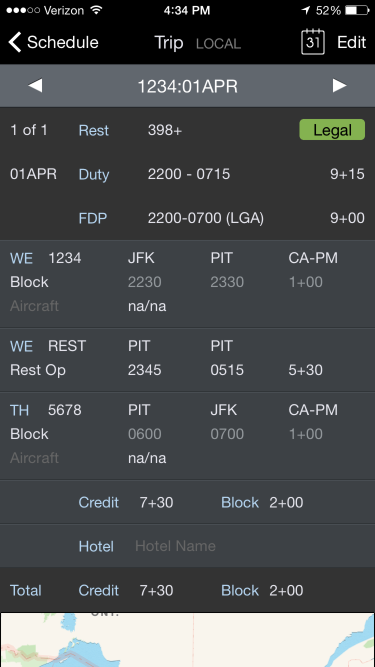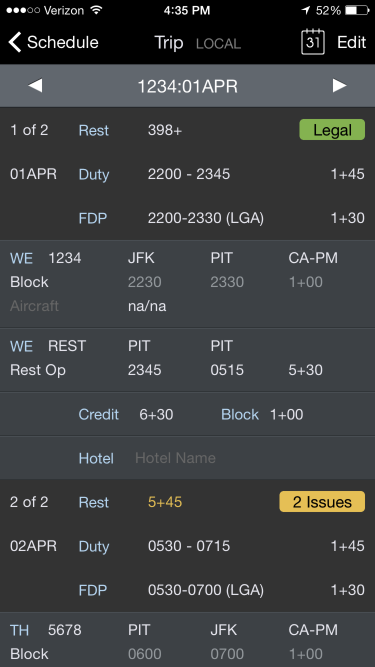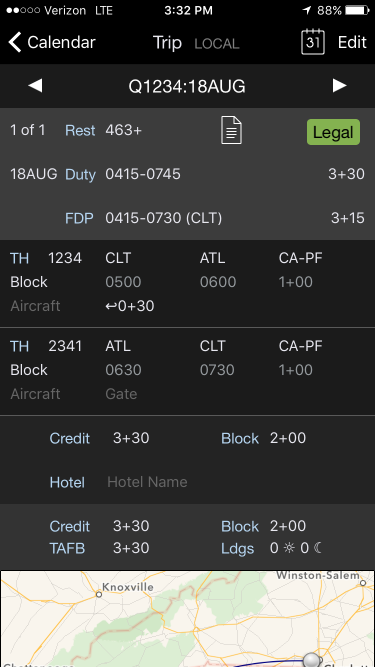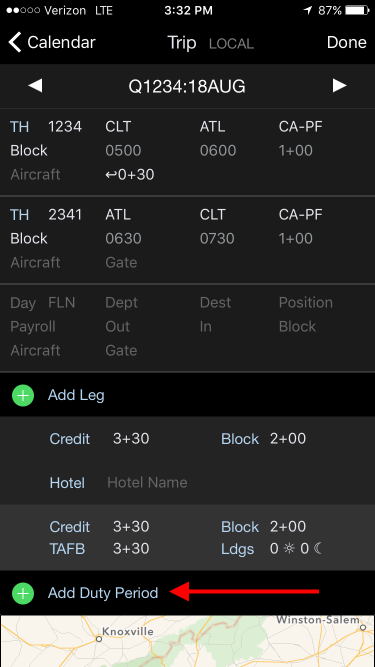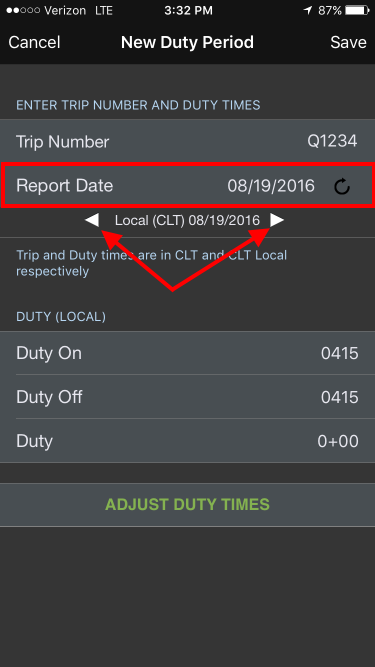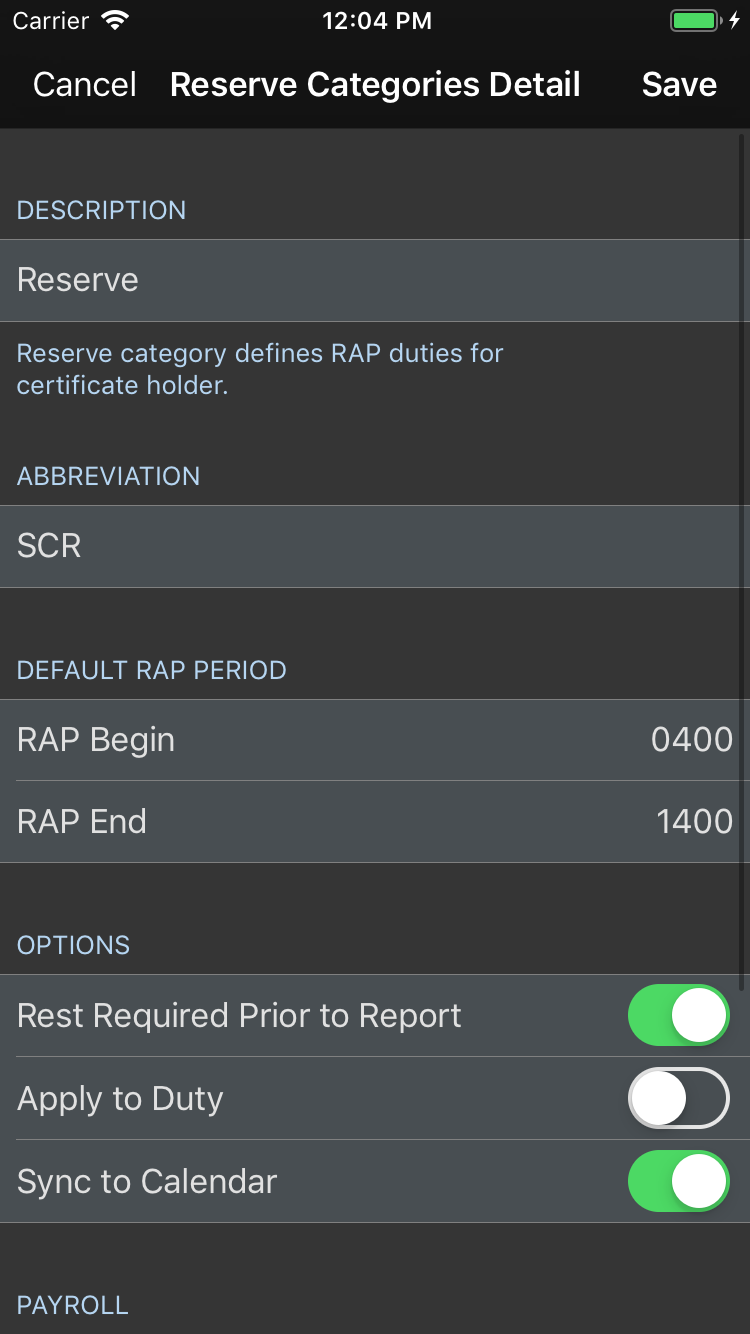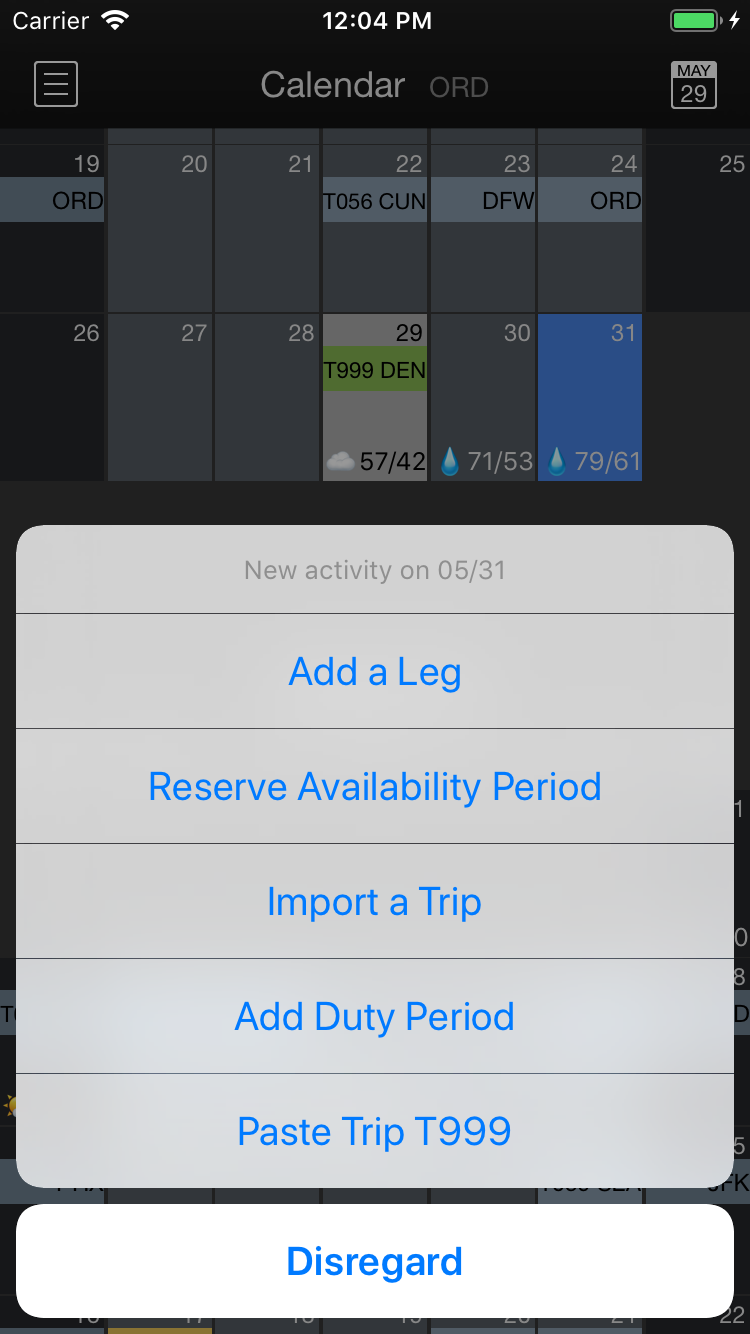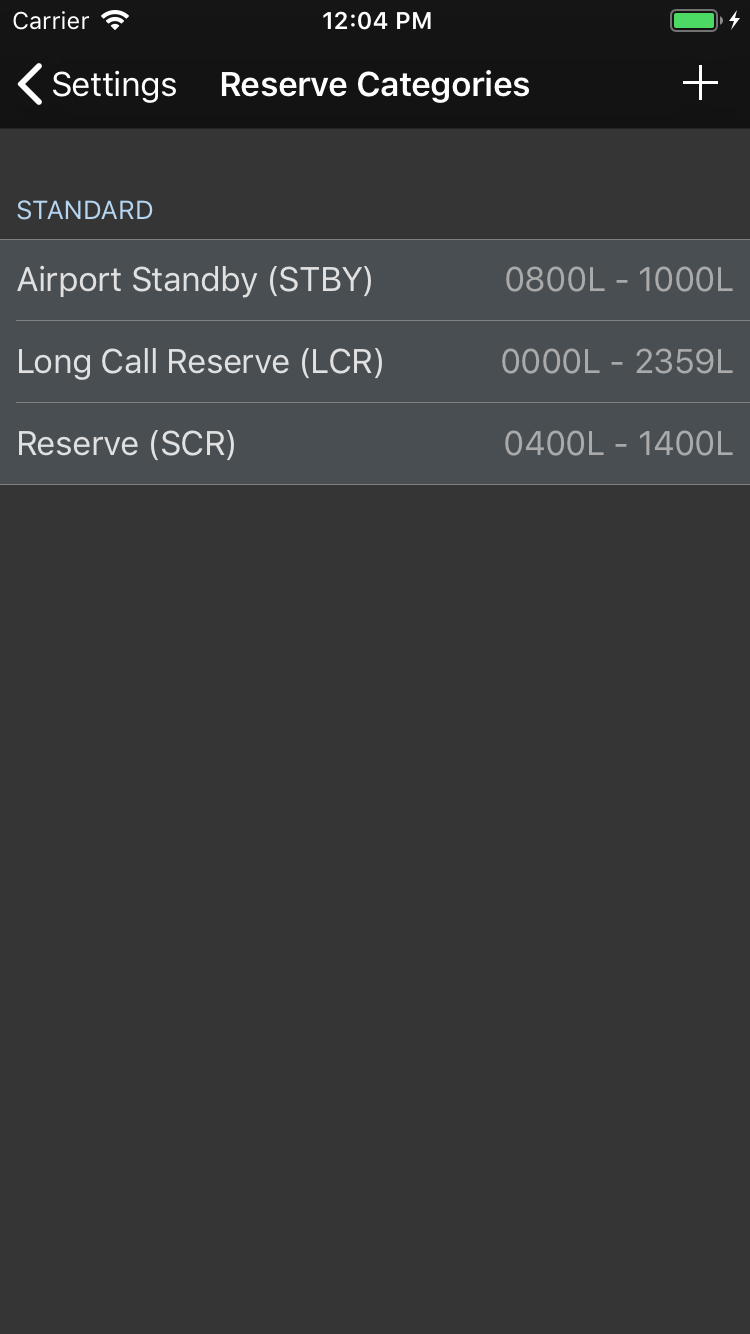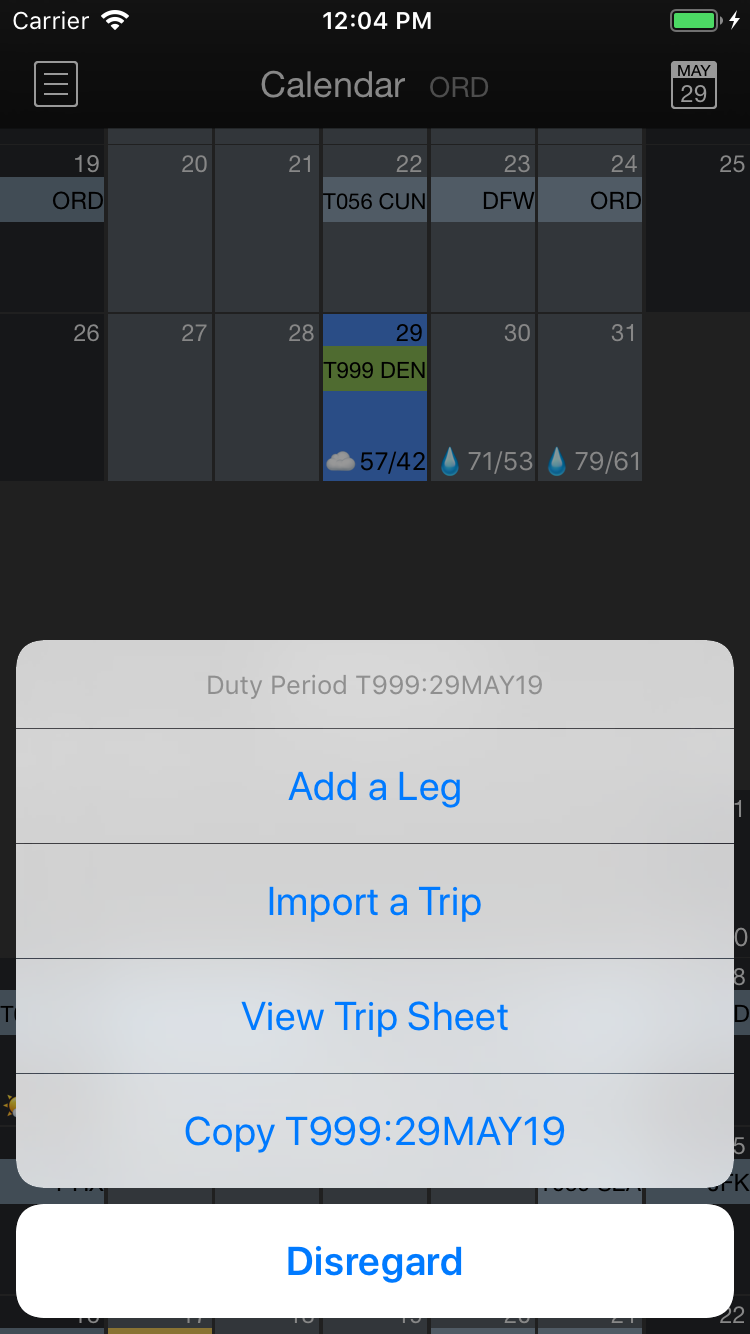Overview
There are several different types of data that can be entered into APDL. Depending on your particular situation, you may or may not need to use all of these types of data.
If you are not using the Airline Schedule Importer, you will need to make all entries manually.
Note
The primary method of using APDL is in conjunction with the Airline Schedule Importer. If you are using the Airline Schedule Importer with APDL, the process of preloading your schedule will be slightly different than described in this section.
Go to the Schedule Importer section for details on preloading your schedule into APDL with the Schedule Importer.
Important!
NC Software highly recommends preloading all available upcoming scheduled data.
Trips
Creating a Trip
Creating a trip can be done in two ways from the Calendar View or Schedule View. To create a new trip, tap on the appropriate blank day. On the popup window, select "Create Duty Period" or "Add a Leg". If you choose "Create Duty Period", this will display a "New Duty Period" window. You must enter the trip number and tap save to continue. Duty on and duty off times may be entered if desired. If you leave the duty times blank, they will be automatically calculated according to your Airline settings. You will now be on the Trip View in "Edit Mode". Tap the "Add Leg" row to add a leg to Day 1 of the trip. Enter the appropriate payroll category, flight number, departure, destination, and scheduled times in order to continue. When entering times, tap the active row to close the time editor or tap the next row to edit the next time. Tap save to return to the trip view.
If you choose "Add a Leg", you can go directly to entering the payroll category, flight number, departure, destination, and scheduled times for the first leg. The duty period will automatically be created for you, respecting your duty period adjustments configured in your Airline settings.
Continue adding legs until you have added all legs for that day. To add another day to the trip, tap the "Add Duty Period" row. This will display another Duty Period window.
Repeat the process above to continue adding days and flights to your trip. When finished entering all legs of the trip, tap the "Done" button at the top right of the screen to exit Edit Mode.
While on the Calendar View or Schedule View, you can also add a leg to an existing duty period by making a long press on that duty period and selecting "Add a Leg".
https://www.youtube.com/watch?v=psY9u_qB3Ps&list=PLt5jhPpkokeL7jZrgoINs1synCP7F3iAy&index=4
Creating a Split Duty Trip
Split duty is a special case that has to be created in APDL slightly differently than a standard trip. As the regulation specifies, split duty flying is considered a single duty period. It must be created in APDL as a single duty period as well. Additionally, this must be manually entered rather than imported. To create a split duty trip, create a trip as described in Creating a Trip above. When adding the first leg, set the regulation to "Part 117 Split Duty". Create another leg in the same duty period (same day) as the first leg and select "Rest Opportunity" as the payroll category. Set the scheduled times as appropriate for the rest opportunity. Create another leg in the same duty period and set the regulation to "Part 117 Split Duty". When setting the OOOI times for this leg, be sure to choose the correct date since it may need to be cycled forward by one day to reflect the correct flight date while being in the same duty period as the previous flight and rest opportunity.
A correctly entered split duty trip looks like this
This is an incorrectly entered split duty trip. Even though these examples use exactly the same OOOI times, entering a split duty trip like this will cause legality errors. APDL sees this as two separate duty periods with insufficient rest between.
Creating A Red Eye Flight
A Red Eye flight can sometimes cause legality issues to pop up in APDL similar to the way a Split Duty Trip can cause legality issues. APDL may indicate you have insufficient rest. This usually occurs when you have a duty period where the last leg is a red eye that departs after midnight. The red eye flight is the last flight in the duty period and must be entered included as part of the same duty period in APDL. This is no different than if you had a late flight that got delayed to the point that it departs after midnight even though it was scheduled to depart before midnight. In this case, the flight would still be entered in APDL with the previous "day" (single duty period) of flights, but the date of the OOOI times would be sequenced to the following date. The schedule importer doesn't understand this and red eyes departing after midnight can sometimes get imported improperly as a single flight in a duty period by itself, usually with only an hour or so of "rest" since the previous flight. If the schedule importer incorrectly imports your red eye flight as a separate duty period you will need to manually delete that duty period and recreate the red eye leg manually. How to Delete a Duty Period
Manually entering a red eye flight is similar to the Creating a Split Duty Trip section above with the exception of the Rest Opportunity. The screenshots in that section also apply to a red eye leg since the legality issue is triggered for the same reason and the incorrect duty period will look the same.
In the case of a red eye, you will not have to create the entire duty period from scratch since you likely already have other flights on the same trip and don't want to recreate the entire trip manually. You can edit the trip by tapping the "Edit" button at the top right. Please see the Creating a Trip section above for details on Edit Mode. Add your red eye leg in the appropriate duty period using Edit Mode. When setting the OOOI times for this leg, be sure to choose the correct date since it may need to be cycled forward by one day to reflect the correct flight date while being in the same duty period as the previous flights.
Two Duty Periods on the Same Day
Similarly to creating a split duty trip, creating two separate duty periods on the same day must be done in a specific way. This can sometimes happen when you have a trip that ends early in the day and a subsequent trip that begins later in the day. To do this in APDL, create the first duty period normally just as described above for a standard trip.
Enter Edit Mode by tapping Edit at the upper right corner and choose "Add Duty Period" at the bottom.
Next, tap the "Report Date" row (red square) to reveal the date selector. In the screenshot below, the date has defaulted to the subsequent day, Aug 19. You can use the left and right arrows to change the date as needed. In our example, we want to create another duty period on Aug 18, so we will tap the left arrow to change the date to Aug 18.
Below we can see that we have now created two separate duty periods on the same day. This is important to differentiate from just adding flights to the first duty period, since this creates a rest period in between.
This technique can also be used to create a trip that has a layover of greater than 24 hours.
Reserve
Creating a Reserve Availability Period
FAR 117 categorizes Reserve Availability Periods (RAP) into different categories. Typically these categories are Long Call Reserve, Short Call Reserve, and Airport/Standby Reserve. APDL also treats Reserve Availability Periods as different categories. A Reserve Category in APDL can be thought of like a Payroll Category. Each Reserve Category has a group of parameters which you can customize to fit the common Reserve assignments issued by your specific company. These parameters include start and end times, a custom label, and some legality options. This allows you to quickly insert Reserve Availability Periods into APDL which are repetitive in nature.
Before you start inserting Reserve Availability Periods in APDL, you'll want to go to Settings > Reserve Categories and configure the Reserve Categories to match the Reserve Availability Periods that are common at your company. For example, your company may have morning Short Call Reserve RAPs that always start at 0500 and afternoon Short Call Reserve RAPs that always start at 1300.
Creating a Reserve Availability Period (RAP) can be done from the Calendar View or Schedule View. To create a new Reserve Availability Period, tap on the appropriate blank day. On the popup window, select "Reserve Availability Period". This will display the "Reserve Categories" window. Select one of your Reserve Categories and it will be immediately added to that day and return you to the Trip View. You can repeat this process very quickly to enter all Reserve Availability Periods on your schedule, even if they are not all the same type.
Adding legs to a RAP functions exactly as described in Creating a Trip above. You can also use a long press on a day on your Calendar or Schedule View which has a RAP on it and select the "Add a Leg" option. This will insert a leg into the existing RAP.
If you have a nonstandard RAP time from your usual RAPs, but need to create more than one that match it for the current week, you can also use the Copy and Paste function described below for RAP.
Important!
For accurate Legality and Payroll results, it is critical that pilots on reserve set ALL legs to Short Call Reserve, Long Call Reserve, or Airport Standby Reserve as appropriate. DO NOT select Block as the payroll category or 117 Unaugmented/Augmented as the regulation while on reserve.
Creating an Airport Standby Period
Creating an Airport Standby Period can be done from the Calendar View or Schedule View. To create a new Airport Standby Period, tap on the appropriate blank day. On the popup window, select "Airport Standby". This will display a "New Duty Period" window. Enter duty on and off times and tap save to continue. You will now be on the Trip View.
Adding legs to an Airport Standby Period functions exactly as described in Creating a Trip above.
Non-Flying Duty
Creating a Non-Flying Duty Period
To create any type of non-flying duty, follow the same initial steps as outlined in Creating a Trip. After the duty period has been created and you are on the Trip View, create a "leg" and change the payroll category to the appropriate selection. Depending on the selection chosen, the "Leg View" layout may be adjusted to reflect the appropriate options for that type of duty.
Copy and Paste a Trip
If you have multiple instances of the same trip on your schedule, you may want to copy and paste that trip rather than creating the entire trip multiple times. To copy and paste a trip, long press on a day of the trip to be copied. Now long press on a blank day to paste in the copied trip.
CAUTION!!
Use extreme caution when copy and pasting trips! Some trips look the same but have slight differences in times which you may not notice at first glance. NC Software recommends only using this feature when the trip numbers are exactly the same.
Resetting Rest
If you need to reset your rest time for any reason, you must create a duty period in APDL. There could be various reasons you may need to reset your rest time, such as an exceptionally long delay in reaching your hotel after landing on the last leg of the day, an interruption in your rest period by crew scheduling, or any task required by your company for any reason. These reasons could include bidding, at home online training, or contacting crew scheduling while off duty for an assignment. If these items are not entered, APDL will continue to calculate rest from the last time you were released from duty. This could potentially result in an undetected illegal rest situation.
To create a non-flying duty period to reset your rest calculation, create a new duty period on the appropriate day. On the "New Duty Period" page, give the duty period a name and set the duty on and duty off times appropriately. If you did some kind of at home training and a start and end time are appropriate, enter those. If your rest was interrupted by contacting scheduling, logging in to a required company system, or some other unforeseen circumstance that simply restarts your rest period, just enter a duty period of at least 1 minute in length. This will restart the rest calculation in APDL.




